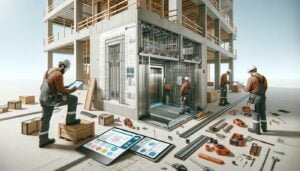
Buildings have traditionally relied on lifts, or elevators, to facilitate the smooth movement of people and products between floors. These systems can be expensive, time-consuming, and difficult to implement. Thankfully, new developments in lift manufacture and design are altering the landscape. Let’s examine how these developments make lift installation easier for people who are unfamiliar with the topic as well as those who are knowledgeable about it.
Sectional Elements
Similar to building blocks in the traditional consutruction are modular components. Like kids assembing blogs to construct places and things, lift makers now assemble lifts out of readily available and designed parts that just need to be bolted and slid togethe. Such a strategy offers a number of advantages:
– Simplicity: Complexities that go with installation are greatly reduced when parts are predefined to join each other instead of doing last-minute and last-mile things just so that they join. Assembling the components then is primarily about adhering to a precise set of instructions.
– Flexibility: Whether a building is a big office complex or a tiny apartment complex, modular elevators can be readily customized to fit individual needs. Such a level of flexibility enables lift installation even in places previously thought to be impractical or prohibitively expensive.
The Pre-Assembled Components
Parts that are already manufactured expand the concept of simplicity. These are assembled at the production facility and then sent, ready to use, to the installation site.
Advantages include:
– Less On-Site Work: Installation teams can set-up lifts faster than before by minimizing the amount of work that needs to be done on-site. This is especially helpful in crowded areas where it’s important to cause as little disruption as possible.
– Reduced Error: The likelihood of errors occurring during installation is reduced when parts are pre-assembled in regulated factory settings. Lifts become safer and more dependable as a result.
Computer Software and Tools
An extremely noteworthy development in lift installation is the use of digital equipment and software. Such tools benefit in a number of ways including:
Planning and envisioning: By simulating the entire lift installation process, software makes it possible to plan ahead more effectively while spotting possible issues before they arise. Time and resources get saved in substaial quantities.
Installation Guidance in real-time: Technicians at site can receive real-time guidance from digital tools to ensure correct execution of every stage in the installation process. This is of extreme importance for novices and those unfamiliar with the procedure.
Effect on Costs and Installation Time
These developments affect lift installation, more so in the following form:
Faster Installation: Lifts can now be installed in a fraction of the time it once took thanks to modular components and pre-assembled sections. This kind of efficiency is critical in initiatives involving rapid building.
Cost Reduction: The total cost of lift installation goes down as the installation procedure cuts down and needs fewer resources, including labor. As a result, a larger variety of buildings can have elevators of just as a diverse kind.
In conclusion, pre-assembled parts, computerized tools, and modular components are revolutionizing the lift installation industry. These developments not only speed up and reduce the cost of the process, but also create new opportunities for lift installation in a variety of environments. We may anticipate significantly easier and more efficient lift installation as these technologies advance.




Add comment